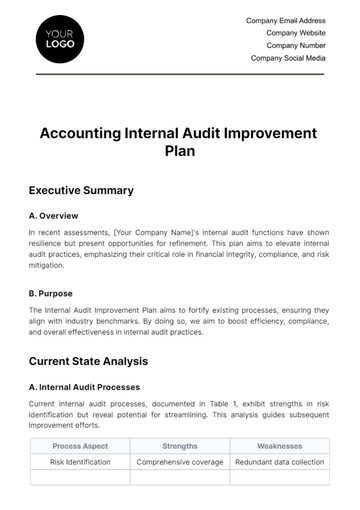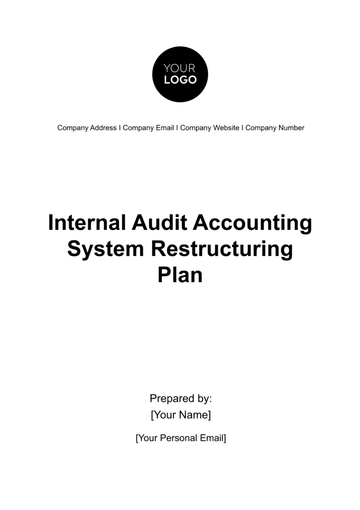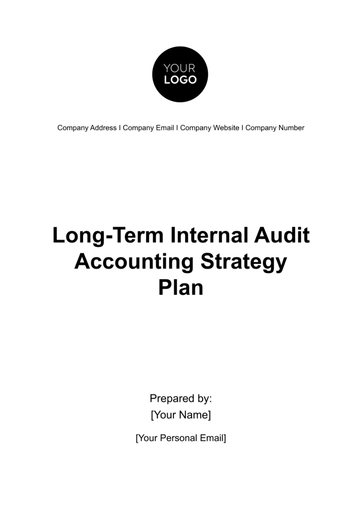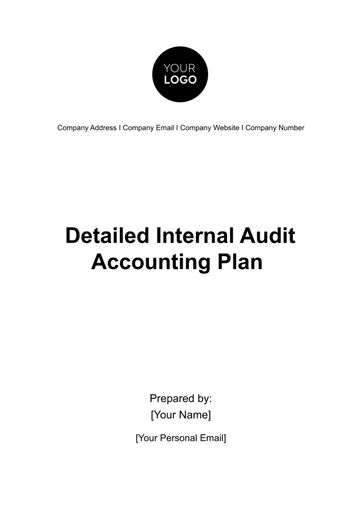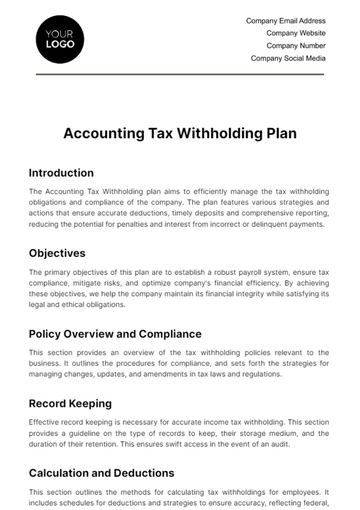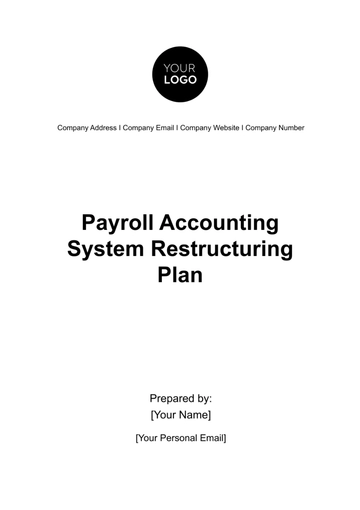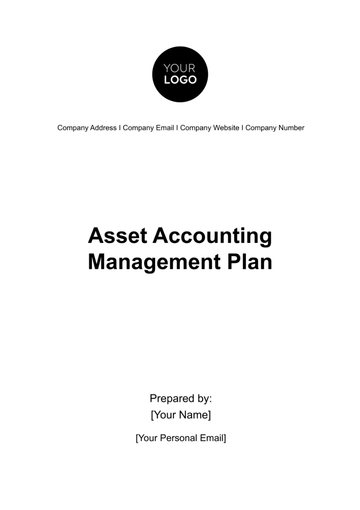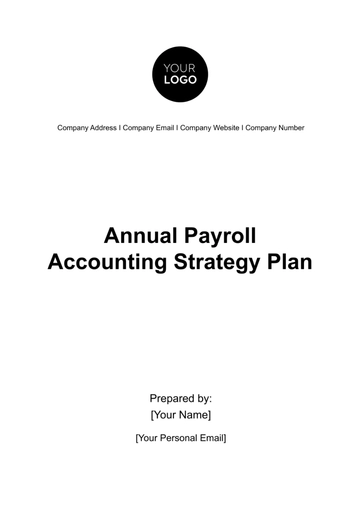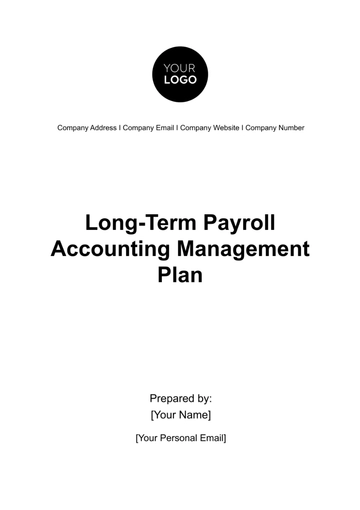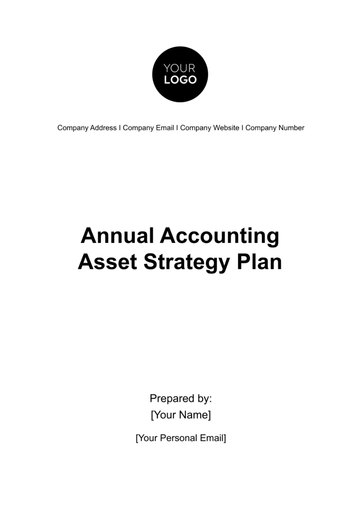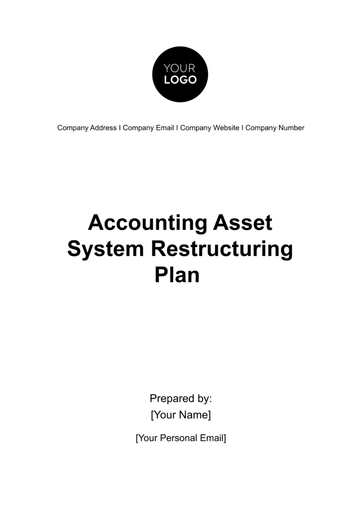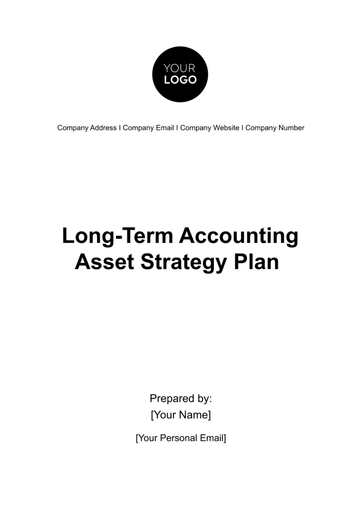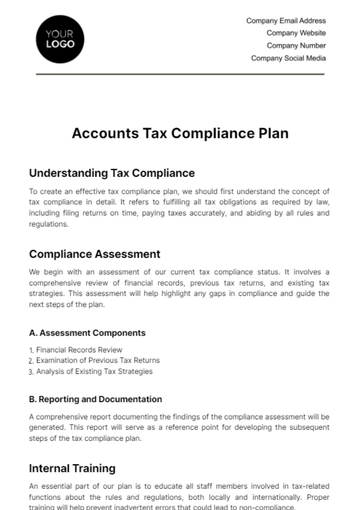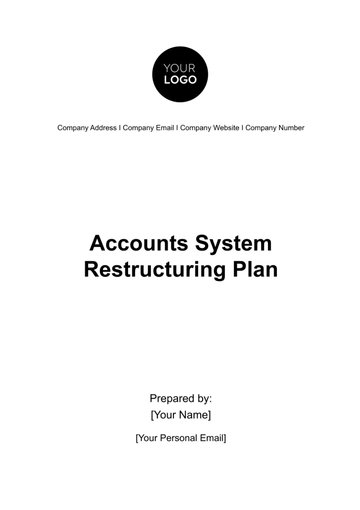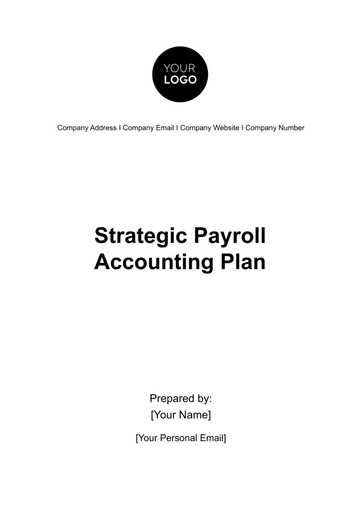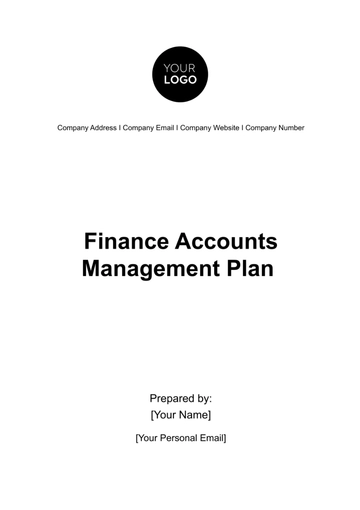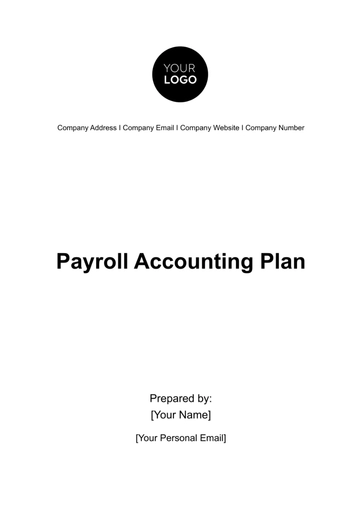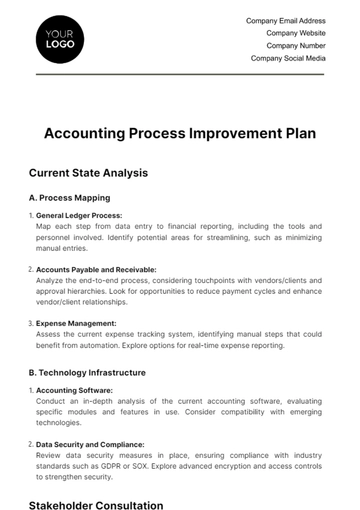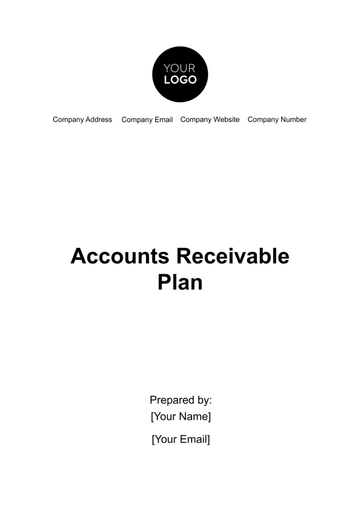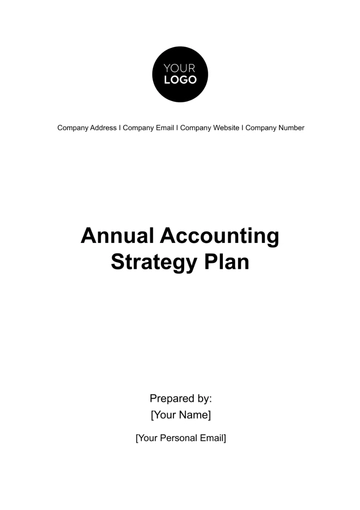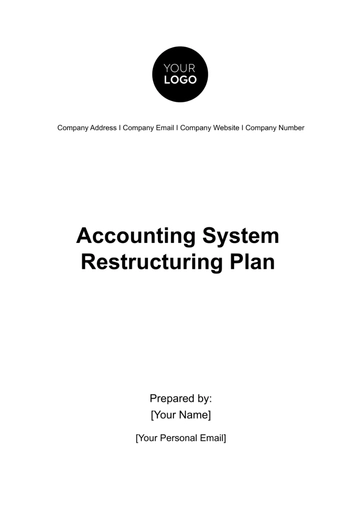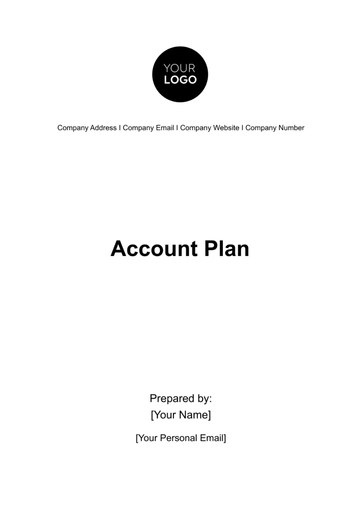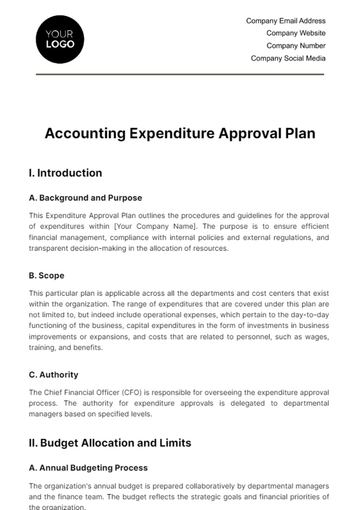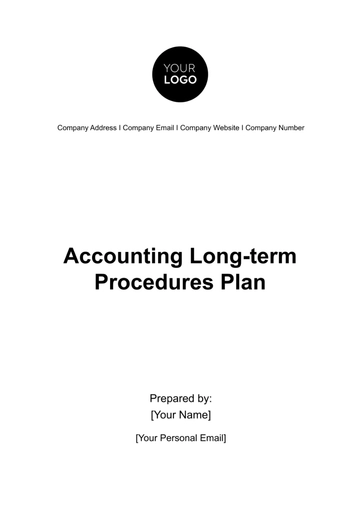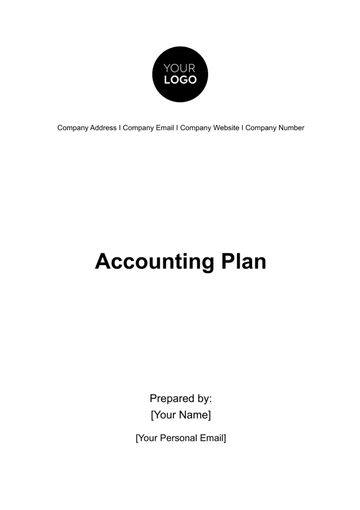Free Payroll Accounting Plan
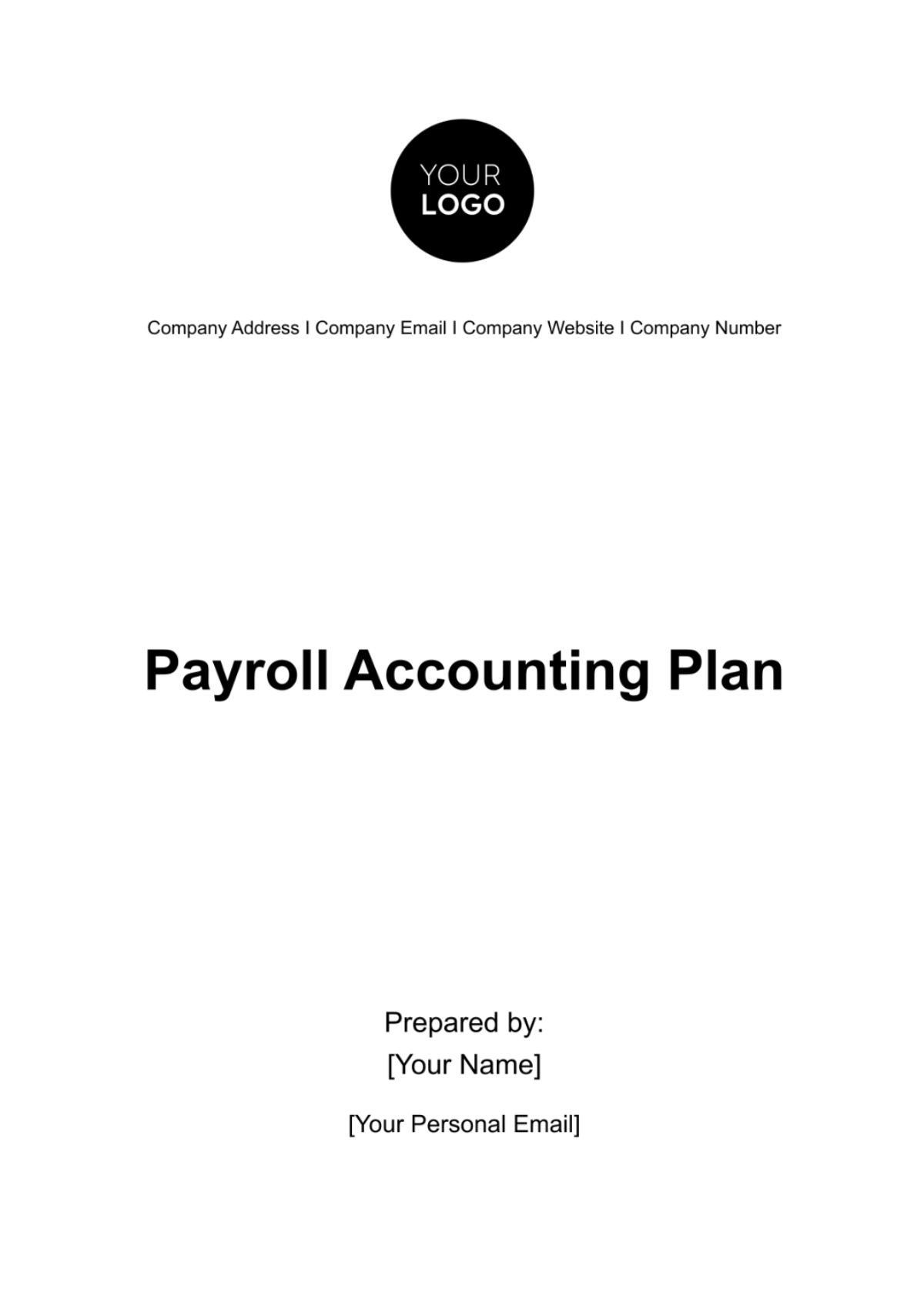
Table of Contents
1. Payroll Regulatory Compliance
1.1 Compliance Audit Strategies
1.2 Regulatory Update Monitoring
1.3 Error Management and Rectification Procedures
2. Payroll Processing Efficiency
2.1 Process Streamlining and Automation
2.2 Time and Resource Management
2.3 Continuous Process Improvement
3. Technology Integration
3.1 Cloud-Based Payroll Solutions
3.2 Automation and AI in Payroll
3.3 Data Security and Integrity
4. Employee Satisfaction and Transparency
4.1 Transparent Payroll Communication
4.2 Employee Self-Service Portals
4.3 Feedback and Improvement Mechanisms
5. Cost Management and Budgeting
5.1 Payroll Expense Tracking and Analysis
5.2 Budget Forecasting and Planning
5.3 Cost Reduction and Efficiency Measures
6. Teaming Up with a Payroll Provider
6.1 Criteria for Selecting a Payroll Provider
6.2 Integrating External Services
6.3 Monitoring and Evaluating Provider Performance
1. Payroll Regulatory Compliance
At [Your Company Name], our Payroll Regulatory Compliance framework is strategically designed to uphold legal integrity and operational excellence. Meticulously conducting audits, actively monitoring regulatory changes, and efficiently managing payroll discrepancies form the pillars of our compliance strategy, ensuring a reliable and compliant payroll system that upholds our high standards of professionalism and ethical responsibility.
1.1 Compliance Audit Strategies
In our comprehensive audit strategy, we conduct systematic, periodic reviews of our payroll processes to ensure strict adherence to evolving tax laws and labor regulations. Employing a blend of advanced analytical tools and expert oversight, we meticulously scrutinize payroll records for accuracy and compliance. Should discrepancies arise, we undertake immediate corrective actions to realign with regulatory standards. This rigorous audit framework not only ensures compliance but also fortifies the financial integrity of [Your Company Name].
1.2 Regulatory Update Monitoring
Our approach to regulatory update monitoring is both proactive and strategic. We leverage cutting-edge digital tools to stay informed about the latest legislative changes impacting payroll. Concurrently, we engage with a network of legal experts who provide specialized guidance on the implications of these changes. This dual-track strategy ensures that [Your Company Name] is not only informed about regulatory updates but is also well-equipped to interpret and apply these changes effectively within our payroll processes.
1.3 Error Management and Rectification Procedures
At the heart of our error management protocol is a commitment to swift resolution and transparency. Our process initiates with the prompt identification and thorough documentation of payroll discrepancies. Immediate steps are then taken to rectify these inaccuracies, be it through payroll adjustments, tax corrections, or supplementary payments. Equally important is our transparent communication with impacted employees, ensuring they are fully informed about the error and the corrective measures undertaken. This strategic approach reinforces trust in our payroll operations and maintains the integrity of [Your Company Name]'s financial practices.
2. Payroll Processing Efficiency
In our pursuit of Payroll Processing Efficiency at [Your Company Name], we focus on optimizing operations through streamlined processes, effective time and resource management, and a commitment to continuous improvement. By implementing innovative automation techniques, strategic time management, and embracing an ethos of perpetual enhancement, we ensure our payroll system operates with maximum efficiency and minimal error.
2.1 Process Streamlining and Automation
We delve into five innovative approaches to refine and automate our payroll processes. By transitioning to electronic systems, leveraging automated data entry, utilizing cloud-based solutions, implementing self-service employee portals, and scheduling regular automation checks, we aim to achieve significant efficiency gains and accuracy in our payroll operations.
Strategy | Description | Expected Outcome |
|---|---|---|
Electronic Payroll Systems | Transition from manual to electronic systems for payroll processing to reduce paperwork and manual errors. | Increased accuracy and speed in payroll processing. |
Automated Data Entry | Implement software for automatic data entry, reducing the need for manual input. | Reduction in time spent on data entry and decrease in human error. |
Cloud-Based Solutions | Use cloud-based payroll systems for real-time data access and integration with other HR systems. | Enhanced data accessibility and streamlined payroll management. |
Self-Service Employee Portals | Allow employees to update their personal information and view payslips online. | Reduced administrative workload and improved employee satisfaction. |
Scheduled Automation Checks | Regularly scheduled automation for repetitive tasks like tax calculations and pay distribution. | Consistent and error-free execution of routine tasks, freeing up staff for more complex activities. |
2.2 Time and Resource Management
This subsection outlines five strategic measures designed to optimize the use of time and resources in payroll processing. These include deploying time-tracking tools, applying a prioritization matrix, cross-training staff, setting clear performance metrics, and outsourcing non-core activities, all aimed at enhancing the efficiency and effectiveness of our payroll system.
Strategy | Description | Expected Benefit |
|---|---|---|
Time-Tracking Tools | Implement time-tracking software to accurately record employee hours worked. | Precise calculation of wages and overtime, leading to fair and accurate payroll. |
Prioritization Matrix | Apply a prioritization matrix to payroll tasks to focus on high-impact activities. | Efficient use of resources, focusing on tasks that offer the most value. |
Cross-Training Staff | Cross-train payroll staff in multiple roles to ensure coverage and reduce dependencies. | Improved flexibility and resource allocation during peak times or staff absences. |
Performance Metrics | Set clear performance metrics for payroll processing to measure efficiency. | Ability to track progress and identify areas for time and resource optimization. |
Outsourcing Non-Core Activities | Outsource non-core payroll activities to specialized providers. | Focus internal resources on strategic tasks while leveraging external expertise. |
2.3 Continuous Process Improvement
In this part, we focus on five key efforts to perpetually enhance our payroll processes. This involves regular review sessions, establishing an employee feedback mechanism, integrating industry best practices, investing in ongoing training and development, and conducting process automation analysis. These efforts are crucial in maintaining a dynamic, efficient, and up-to-date payroll system.
Effort | Description | Impact |
|---|---|---|
Regular Review Sessions | Conduct periodic reviews of payroll processes to identify inefficiencies. | Continuous identification and resolution of process bottlenecks. |
Employee Feedback Mechanism | Implement a system for collecting feedback from employees on payroll processes. | Insights into user experience, leading to user-centered improvements. |
Best Practice Implementation | Stay updated with industry best practices and integrate them into our processes. | Ensuring our payroll system is aligned with the latest and most efficient practices. |
Training and Development | Regular training sessions for payroll staff on new technologies and methodologies. | A highly skilled team capable of adapting to and implementing new efficiencies. |
Process Automation Analysis | Analyze existing processes to identify areas where automation can be further implemented. | Enhanced efficiency through the identification of new automation opportunities. |
3. Technology Integration
At [Your Company Name], our Technology Integration strategy is focused on harnessing the power of modern solutions to revolutionize payroll management. By adopting cloud-based systems, integrating automation and AI, and ensuring the highest standards of data security and integrity, we create a payroll system that is not only efficient and scalable but also secure and forward-looking.
3.1 Cloud-Based Payroll Solutions
Explore the transformative impact of cloud technology on payroll systems. This section highlights key advantages such as scalability, enhanced accessibility, improved security features, seamless integration capabilities, and real-time updates, demonstrating how cloud-based solutions significantly elevate the efficiency and adaptability of our payroll processes.
Advantage | Description | Impact on Payroll |
|---|---|---|
Scalability | Cloud-based systems can easily adapt to the changing size and needs of the business. | Efficiently manage payroll for an increasing or fluctuating number of employees. |
Accessibility | Access payroll data from anywhere, enabling remote work and flexibility. | Enhances payroll team's ability to work efficiently from various locations. |
Enhanced Security | Advanced security protocols inherent in cloud solutions, like secure data centers. | Protects sensitive payroll data from unauthorized access and breaches. |
Integration Capabilities | Ability to integrate with other HR and financial systems. | Streamlines processes and improves data consistency across departments. |
Real-Time Updates | Immediate updates and upgrades without significant downtime or manual intervention. | Keeps the payroll system up-to-date with the latest features and security patches. |
3.2 Automation and AI in Payroll
Delve into the integration of advanced technology in payroll management. We discuss the utilization of automation and artificial intelligence for error reduction, predictive analytics, compliance monitoring, and process optimization. This section illustrates how AI enhances payroll accuracy, efficiency, and strategic planning.
Application | Description | Benefit |
|---|---|---|
Automated Data Entry | AI algorithms for entering and verifying payroll data. | Reduces manual errors and saves time on data entry. |
Predictive Analytics | AI-driven analytics to forecast payroll trends and needs. | Assists in strategic planning and resource allocation. |
Compliance Monitoring | Automated monitoring of regulatory changes affecting payroll. | Ensures continuous compliance with laws and regulations. |
Chatbots for Employee Queries | AI-powered chatbots to answer common payroll-related queries. | Enhances employee experience and reduces the workload on payroll staff. |
Process Optimization | AI algorithms to identify inefficiencies in payroll processes. | Streamlines workflows and increases overall efficiency. |
3.3 Data Security and Integrity
In this part, we emphasize the paramount importance of protecting payroll data. This section outlines comprehensive measures such as encryption, access control, regular security audits, robust backup and recovery plans, and employee data privacy training, ensuring the highest standards of security and integrity in our payroll management system.
Measure | Description | Effectiveness |
|---|---|---|
Encryption | Use of advanced encryption protocols for data at rest and in transit. | Secures sensitive payroll information from potential cyber threats. |
Access Control | Implementation of strict access control policies and authentication procedures. | Ensures that only authorized personnel can access payroll data. |
Regular Security Audits | Conducting frequent security audits to identify and address vulnerabilities. | Maintains the integrity and security of the payroll system. |
Backup and Recovery Plans | Robust data backup and recovery strategies to prevent data loss. | Guarantees data availability and continuity in case of system failures. |
Employee Data Privacy Training | Regular training for staff on data privacy and security best practices. | Cultivates a culture of security awareness and responsibility. |
4. Employee Satisfaction and Transparency
Our approach to Employee Satisfaction and Transparency at [Your Company Name] emphasizes clear, open communication and empowering employees with self-service tools. By implementing strategic communication practices, user-friendly self-service portals, and effective feedback mechanisms, we aim to enhance employee engagement and trust in our payroll processes.
4.1 Transparent Payroll Communication
This subsection focuses on establishing clear, open channels of communication regarding payroll. This section details five strategic approaches, including comprehensive updates, accessible explanations, regular briefings, multichannel communication, and visibility of payroll policy changes, all aimed at enhancing transparency and understanding among employees.
Strategy | Description | Impact on Employees |
|---|---|---|
Comprehensive Updates | Regular, detailed updates on payroll changes and their implications. | Ensures employees are always informed and prepared for any changes. |
Accessible Explanations | Simplified explanations of deductions, benefits, and payroll calculations. | Helps employees understand their pay structure and entitlements. |
Regular Briefings | Scheduled meetings or webinars to discuss payroll-related matters. | Facilitates direct communication and allows for immediate questions. |
Multichannel Communication | Utilizing various channels like email, intranet, and newsletters for payroll information dissemination. | Ensures reach to all employees, catering to different communication preferences. |
Visibility of Policy Changes | Transparently communicating any payroll policy changes to all employees. | Builds trust and reduces uncertainties or misconceptions. |
4.2 Employee Self-Service Portals
This part describes the implementation and advantages of providing employees with direct access to their payroll information. This section outlines the features of these portals, including pay slip access, personal information management, benefits overview, document access, and change request capabilities, all designed to empower employees and streamline payroll interactions.
Feature | Functionality | Employee Benefit |
|---|---|---|
Pay Slip Access | Online access to current and past pay slips. | Enables employees to view and download their pay slips at their convenience. |
Personal Information Management | Ability to update personal details like bank information and contact details. | Empowers employees to manage their own information, ensuring accuracy. |
Benefits Overview | Comprehensive view of employee benefits and eligibility. | Helps employees understand and maximize their benefits. |
Document Access | Access to payroll-related documents such as tax forms. | Provides easy retrieval of important payroll documents. |
Change Request Capabilities | Submit requests for changes or corrections in payroll. | Streamlines the process for addressing payroll discrepancies or updates. |
4.3 Feedback and Improvement Mechanisms
Here, we emphasize the importance of employee input in refining payroll services. This section explores the establishment of feedback channels, the process of feedback analysis, implementation of suggestions, regular feedback solicitation, and transparency in feedback application, all aimed at continuously improving our payroll system in line with employee needs.
Mechanism | Description | Purpose and Outcome |
|---|---|---|
Feedback Channels | Multiple avenues for employees to provide feedback on payroll services. | Facilitates easy and comfortable sharing of feedback by employees. |
Feedback Analysis | Systematic analysis of received feedback for actionable insights. | Identifies areas of improvement and employee concerns. |
Implementation of Suggestions | Actively applying employee suggestions where feasible. | Shows employees that their input is valued and leads to tangible changes. |
Regular Feedback Solicitation | Proactively seeking feedback through surveys and focus groups. | Keeps the organization in touch with employee sentiment and needs. |
Transparency in Feedback Application | Communicating how feedback is being used to improve payroll services. | Builds trust and demonstrates the organization's commitment to improvement. |
Through these comprehensive strategies, [Your Company Name] is committed to fostering a culture of transparency and responsiveness, ensuring that our payroll services not only meet but also exceed the expectations and needs of our valued employees.
5. Cost Management and Budgeting
In the Cost Management and Budgeting section at [Your Company Name], we focus on meticulous management of payroll expenses, strategic forecasting, and implementing cost-saving measures. This approach ensures alignment with our financial goals, allowing for a more efficient and economically sustainable payroll system.
5.1 Payroll Expense Tracking and Analysis
This subsection is dedicated to outlining five robust methods to monitor and analyze payroll expenses. These methods include the utilization of specialized software, regular expense auditing, department-wise cost analysis, real-time expense tracking, and variance analysis, each contributing to a clear understanding and effective management of payroll costs.
Method | Description | Benefit |
|---|---|---|
Specialized Software | Implementing payroll management software with robust tracking features. | Facilitates accurate and efficient tracking of all payroll expenses. |
Regular Expense Auditing | Periodic audits to review and verify payroll expenditures. | Ensures accuracy and identifies areas of potential overspending. |
Department-wise Cost Analysis | Analyzing payroll costs by department to identify specific cost drivers. | Enables targeted cost management strategies in high-expense areas. |
Real-Time Expense Tracking | Monitoring payroll expenses as they occur. | Provides immediate insights into spending patterns and anomalies. |
Variance Analysis | Comparing actual payroll expenses against budgeted figures. | Helps in identifying and understanding deviations from the budget. |
5.2 Budget Forecasting and Planning
This part outlines five strategic approaches to anticipate and plan for future payroll expenditures. This includes using advanced financial modeling, historical trend analysis, scenario planning, collaboration with other departments, and regular budget review and adjustment, ensuring our payroll budget is both realistic and aligned with company objectives.
Strategy | Description | Impact |
|---|---|---|
Financial Modeling Tools | Utilizing advanced tools to project future payroll costs. | Provides a data-driven basis for budgeting decisions. |
Historical Trend Analysis | Analyzing past payroll data to forecast future trends. | Helps in predicting future costs based on historical patterns. |
Scenario Planning | Creating budget scenarios based on different business conditions. | Prepares the payroll budget for various potential future states. |
Cross-Departmental Collaboration | Collaborating with other departments for holistic budget planning. | Ensures all factors affecting payroll are considered in the budget. |
Regular Budget Review | Periodically revisiting the budget for necessary adjustments. | Keeps the payroll budget aligned with changing business needs. |
5.3 Cost Reduction and Efficiency Measures
In this subsection, we discuss five strategic measures aimed at reducing payroll processing costs. Strategies include renegotiating contracts with providers, automating payroll processes, conducting regular efficiency audits, outsourcing non-core payroll functions, and continuous process improvement, each contributing to a more cost-effective and efficient payroll operation.
Strategy | Description | Result |
|---|---|---|
Renegotiating Provider Contracts | Seeking more favorable terms with payroll service providers. | Reduces external service costs without compromising quality. |
Automation of Processes | Implementing automated systems to reduce manual labor costs. | Increases efficiency and reduces the need for extensive manpower. |
Regular Efficiency Audits | Conducting audits to identify areas of wasteful expenditure. | Pinpoints opportunities for cost savings in payroll operations. |
Outsourcing Non-Core Functions | Outsourcing tasks like tax filing to specialized agencies. | Focuses internal resources on core activities while reducing costs. |
Continuous Process Improvement | Regularly updating processes for maximum efficiency. | Ensures ongoing optimization of payroll operations for cost savings. |
Through these comprehensive methods and strategies, [Your Company Name] is committed to managing payroll expenses judiciously, forecasting accurately, and continuously seeking ways to enhance efficiency and reduce costs, aligning our payroll operations with our broader financial objectives.
6. Teaming Up with a Payroll Provider
We emphasize the strategic selection, integration, and ongoing evaluation of external payroll providers. This approach ensures we partner with services that offer reliability, expertise, and cost-effectiveness, while seamlessly integrating their solutions into our operations and continually assessing their performance to maintain high standards.
6.1 Criteria for Selecting a Payroll Provider
This part outlines the essential factors we consider when choosing an external payroll service. These criteria, including provider reputation, technological compatibility, service range, cost-effectiveness, and customer support quality, guide us in partnering with a provider that aligns with our organizational needs and standards.
Criteria | Description | Importance |
|---|---|---|
Provider Reputation | Assessing the market reputation and client feedback. | Ensures reliability and proven track record of the provider. |
Technological Compatibility | Compatibility of provider's technology with our systems. | Facilitates smooth integration and operation. |
Range of Services Offered | Diversity and comprehensiveness of services provided. | Matches our payroll needs and future scalability. |
Cost-Effectiveness | Evaluating the cost relative to the services offered. | Ensures value for money and budget alignment. |
Quality of Customer Support | Availability and quality of provider’s customer service. | Guarantees assistance and resolution of issues promptly. |
6.2 Integrating External Services
This subsection details the process and considerations involved in incorporating a payroll provider's services into our existing system. This includes assessing system compatibility, developing an integration plan, training staff on new tools, setting up communication channels, and conducting pilot testing, all aimed at ensuring a seamless and efficient integration.
Aspect | Process | Goal |
|---|---|---|
System Compatibility Assessment | Evaluating how the provider's system integrates with ours. | Ensures technical feasibility and efficiency. |
Integration Plan Development | Creating a detailed plan for integration steps. | Facilitates an organized and structured integration process. |
Staff Training | Training staff on new tools and processes. | Ensures smooth adoption and utilization of new systems. |
Communication Channels Setup | Establishing clear communication lines with the provider. | Enables effective coordination and support. |
Pilot Testing | Running a test phase to assess integration effectiveness. | Identifies and addresses any issues before full-scale implementation. |
6.3 Monitoring and Evaluating Provider Performance
We establish the metrics and processes for continuously assessing our payroll provider. This includes defining performance indicators, regular review meetings, feedback collection from users, service level agreement (SLA) adherence checks, and conducting periodic audits, ensuring the provider consistently meets and exceeds our expectations and requirements.
Metric/Process | Description | Purpose |
|---|---|---|
Performance Indicators Definition | Setting clear and measurable performance goals. | Provides objective criteria to evaluate provider’s performance. |
Regular Review Meetings | Scheduling routine meetings to discuss performance. | Facilitates ongoing communication and performance tracking. |
User Feedback Collection | Gathering input from staff using the provider's services. | Assesses user satisfaction and identifies improvement areas. |
SLA Adherence Checks | Monitoring compliance with the agreed service levels. | Ensures the provider meets contractual obligations. |
Periodic Audits | Conducting audits to independently assess provider performance. | Provides an unbiased evaluation of service effectiveness. |
Through these detailed and methodical strategies, [Your Company Name] ensures that our partnership with a payroll provider not only integrates seamlessly into our existing framework but also continually aligns with our high standards of efficiency, reliability, and overall service excellence.
Plan Created by: [Your Name]
- 100% Customizable, free editor
- Access 1 Million+ Templates, photo’s & graphics
- Download or share as a template
- Click and replace photos, graphics, text, backgrounds
- Resize, crop, AI write & more
- Access advanced editor
Streamline your fiscal efficiency with Template.net's Payroll Accounting Plan. This template is customizable and editable, allowing precision tailored to your unique needs. Conquer accounting complexity with flexibility using our AI Editor Tool. Reimagine financial management - an engaging, professional solution is just one click away. Edit, customize, save time.
You may also like
- Finance Plan
- Construction Plan
- Sales Plan
- Development Plan
- Career Plan
- Budget Plan
- HR Plan
- Education Plan
- Transition Plan
- Work Plan
- Training Plan
- Communication Plan
- Operation Plan
- Health And Safety Plan
- Strategy Plan
- Professional Development Plan
- Advertising Plan
- Risk Management Plan
- Restaurant Plan
- School Plan
- Nursing Home Patient Care Plan
- Nursing Care Plan
- Plan Event
- Startup Plan
- Social Media Plan
- Staffing Plan
- Annual Plan
- Content Plan
- Payment Plan
- Implementation Plan
- Hotel Plan
- Workout Plan
- Accounting Plan
- Campaign Plan
- Essay Plan
- 30 60 90 Day Plan
- Research Plan
- Recruitment Plan
- 90 Day Plan
- Quarterly Plan
- Emergency Plan
- 5 Year Plan
- Gym Plan
- Personal Plan
- IT and Software Plan
- Treatment Plan
- Real Estate Plan
- Law Firm Plan
- Healthcare Plan
- Improvement Plan
- Media Plan
- 5 Year Business Plan
- Learning Plan
- Marketing Campaign Plan
- Travel Agency Plan
- Cleaning Services Plan
- Interior Design Plan
- Performance Plan
- PR Plan
- Birth Plan
- Life Plan
- SEO Plan
- Disaster Recovery Plan
- Continuity Plan
- Launch Plan
- Legal Plan
- Behavior Plan
- Performance Improvement Plan
- Salon Plan
- Security Plan
- Security Management Plan
- Employee Development Plan
- Quality Plan
- Service Improvement Plan
- Growth Plan
- Incident Response Plan
- Basketball Plan
- Emergency Action Plan
- Product Launch Plan
- Spa Plan
- Employee Training Plan
- Data Analysis Plan
- Employee Action Plan
- Territory Plan
- Audit Plan
- Classroom Plan
- Activity Plan
- Parenting Plan
- Care Plan
- Project Execution Plan
- Exercise Plan
- Internship Plan
- Software Development Plan
- Continuous Improvement Plan
- Leave Plan
- 90 Day Sales Plan
- Advertising Agency Plan
- Employee Transition Plan
- Smart Action Plan
- Workplace Safety Plan
- Behavior Change Plan
- Contingency Plan
- Continuity of Operations Plan
- Health Plan
- Quality Control Plan
- Self Plan
- Sports Development Plan
- Change Management Plan
- Ecommerce Plan
- Personal Financial Plan
- Process Improvement Plan
- 30-60-90 Day Sales Plan
- Crisis Management Plan
- Engagement Plan
- Execution Plan
- Pandemic Plan
- Quality Assurance Plan
- Service Continuity Plan
- Agile Project Plan
- Fundraising Plan
- Job Transition Plan
- Asset Maintenance Plan
- Maintenance Plan
- Software Test Plan
- Staff Training and Development Plan
- 3 Year Plan
- Brand Activation Plan
- Release Plan
- Resource Plan
- Risk Mitigation Plan
- Teacher Plan
- 30 60 90 Day Plan for New Manager
- Food Safety Plan
- Food Truck Plan
- Hiring Plan
- Quality Management Plan
- Wellness Plan
- Behavior Intervention Plan
- Bonus Plan
- Investment Plan
- Maternity Leave Plan
- Pandemic Response Plan
- Succession Planning
- Coaching Plan
- Configuration Management Plan
- Remote Work Plan
- Self Care Plan
- Teaching Plan
- 100-Day Plan
- HACCP Plan
- Student Plan
- Sustainability Plan
- 30 60 90 Day Plan for Interview
- Access Plan
- Site Specific Safety Plan

